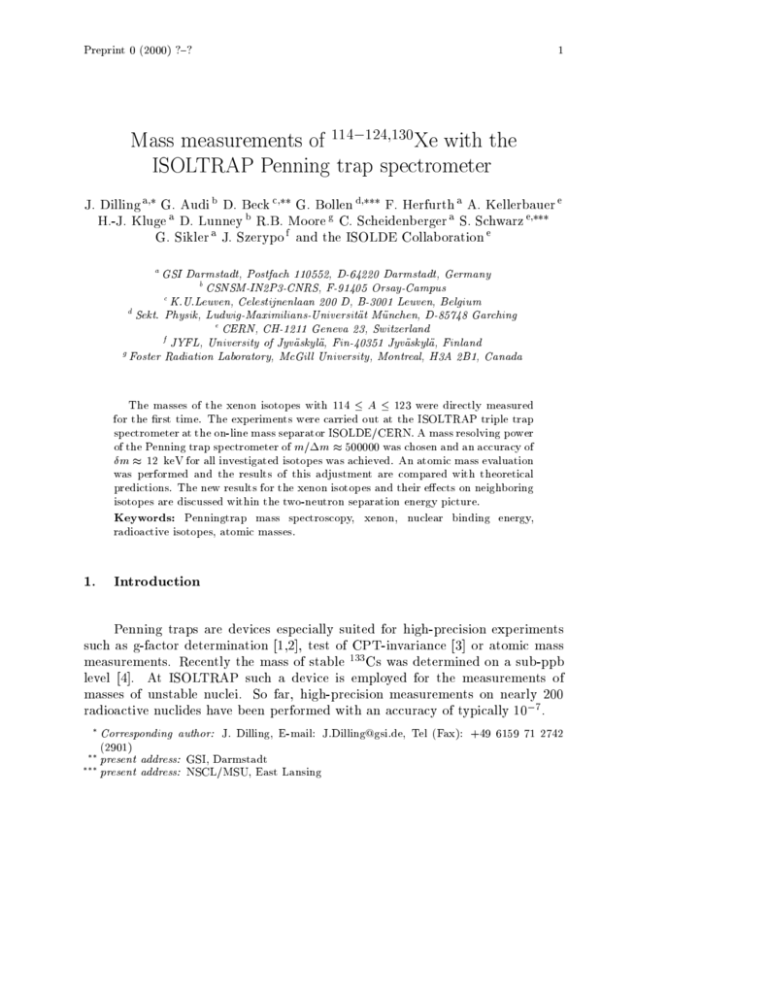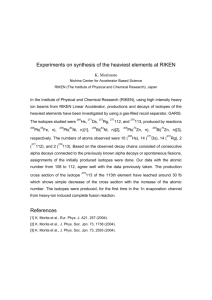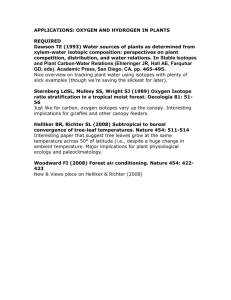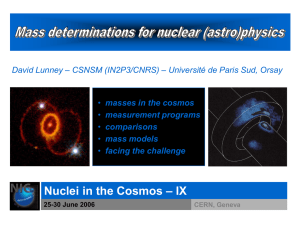Mass measurements of 114-124,130Xe with the ISOLTRAP Penning
advertisement

Preprint 0 (2000) ?{?
1
Mass measurements of 114 124 130Xe with the
ISOLTRAP Penning trap spectrometer
;
c G. Bollen d F. Herfurth a A. Kellerbauer e
J. Dilling a G.a Audi b D. Beck
b
g C. Scheidenberger a S. Schwarz e H.-J. Kluge D. Lunney
R.B.
Moore
G. Sikler a J. Szerypo f and the ISOLDE Collaboration e
;
;
;
;
a
GSI Darmstadt, Postfach 110552, D-64220 Darmstadt, Germany
b
c
d
CSNSM-IN2P3-CNRS, F-91405 Orsay-Campus
K.U.Leuven, Celestijnenlaan 200 D, B-3001 Leuven, Belgium
Sekt. Physik, Ludwig-Maximilians-Universit
at M
unchen, D-85748 Garching
e
f
g
CERN, CH-1211 Geneva 23, Switzerland
JYFL, University of Jyv
askyl
a, Fin-40351 Jyv
askyl
a, Finland
Foster Radiation Laboratory, McGill University, Montreal, H3A 2B1, Canada
The masses of the xenon isotopes with 114 A 123 were directly measured
for the rst time. The experiments were carried out at the ISOLTRAP triple trap
spectrometer at the on-line mass separator ISOLDE/CERN. A mass resolving power
of the Penning trap spectrometer of m=m 500000 was chosen and an accuracy of
Æm 12 keV for all investigated isotopes was achieved. An atomic mass evaluation
was performed and the results of this adjustment are compared with theoretical
predictions. The new results for the xenon isotopes and their eects on neighboring
isotopes are discussed within the two-neutron separation energy picture.
Penningtrap mass spectroscopy, xenon, nuclear binding energy,
radioactive isotopes, atomic masses.
Keywords:
1.
Introduction
Penning traps are devices especially suited for high-precision experiments
such as g-factor determination [1,2], test of 133
CPT-invariance [3] or atomic mass
measurements. Recently the mass of stable Cs was determined on a sub-ppb
level [4]. At ISOLTRAP such a device is employed for the measurements of
masses of unstable nuclei. So far, high-precision measurements on nearly7 200
radioactive nuclides have been performed with an accuracy of typically 10 .
Corresponding
(2901)
present address:
present
J. Dilling, E-mail: J.Dilling@gsi.de, Tel (Fax): +49 6159 71 2742
GSI, Darmstadt
NSCL/MSU, East Lansing
author:
address:
2
2.
J. Dilling et al. / Mass measurements of
114 124;130
Xe at ISOLTRAP
Set-Up
The ISOLTRAP mass spectrometer is installed at the on-line facility
ISOLDE/CERN in Geneva. It consists of a linear radio frequency quadrupole
(RFQ) trap [5] and two Penning traps [6,7]. The quasi-continuous ion beam delivered by ISOLDE with typically 30 or 60 keV is injected into the linear RFQ
trap lled with He buer gas. Here, the beam is electrostatically retarded, cooled
by buer gas collisions, bunched and extracted at low energy. The ions at typical
2.5 keV transport energy are transferred to the rst Penning trap where mass
selective buer gas cooling is applied to further cool and isobarically clean the ion
sample. Subsequently these ions with a charge-to-mass ratio q=m are delivered to
the precision Penning trap where their cyclotron frequency = q=m B=2 is determined. The cyclotron frequency is determined by exiting the ion motion with
a radiofrequency eld for a period T and by employing a time-of-ight technique. The133magnetic eld B is calibrated via a cyclotron frequency measurement
of stable Cs, delivered from a test ion source.
c
RF
3.
Measurements
In the case of the here presented Xe mass measurements a radiofrequency
excitation time of the
ions of T = 0:9 s was chosen resulting in a resolving
power of R = 5 105 . With typically 6000 detected ions per
isotope a statistical
8
accuracy in the mass determination of Æm=m = 3 10 was achieved. As a7
conservative estimate of possible systematic errors an additional error of 1 10
is added quadratically yielding a total uncertainty for ISOLTRAP mass values of
all xenon isotopes of Æm 12 keV.
RF
4.
Results
Mass measurements were performed for the Xe isotopes with mass number
114 A 124 and A = 130. Figure 1 on the left shows the dierence between
mass values from the Atomic Mass Evaluation 1995 114
(AME 115
95) and an 116
evaluation
including the new ISOLTRAP data. The
masses
of
Xe,
Xe,
and
Xe were
previously unknown. In the case of 118 Xe, the experimental mass uncertainty
could
be reduced by a factor of 100 whereas the uncertainties of the masses of
117 Xe and 119 Xe are reduced by one order of magnitude. The masses of 124 Xe
and 130 Xe are known from literature with124high accuracy. The deviation of130those
values from the ISOLTRAP data is Æm( Xe) = 1 12.5 keV and Æm ( Xe)
= 3 13 keV demonstrating
the reliability of the ISOLTRAP data.
120
In the case of Xe, a drastic discrepancy by 8 standard deviations between
the literature value and the ISOLTRAP
result was observed whereas smaller deviations were measured for 121 Xe (3), 122 Xe (2), and 118 Xe and 119 Xe (1).
J. Dilling et al. / Mass measurements of
114 124;130
Xe at ISOLTRAP
3
Figure 1. Left: Dierence between mass values from the Atomic Mass Evaluation 1995 (AME
95) [8] (data points with error bars) and an evaluation including the ISOLTRAP data (zero line
with error band). For isotopes marked with # masses are estimated from the extrapolation of
systematic trends [8]. Right: Two-neutron separation energy S2 as a function of mass number
A. Filled circles show the new values, open circles old data from AME 95. No error-bars are
shown.
n
The discrepancies were mainly due to incorrect -endpoint measurements or underestimation of errors for those. The high-accuracy ISOLTRAP data inuence
via the manifold correlations quite a number of mass values of other isotopes.
This impact can be seen most directly by a plot of the two-neutron separation
energies in the xenon region as a function of mass number A (Fig. 1, right). Open
circles indicate literature values taken from the previously published atomic mass
evaluation AME 95 [8]. The 23 S2 -values determined or signicantly changed
by the present work are shown as full dots.
Generally, a very smooth behaviour of the two-neutron separation energies
(especially for the nuclides with even proton number) is found in this region of the
chart of nuclides, indicating the absence of any drastic nuclear structure eects
in these neutron mid-shell nuclides. The only stronger irregularities observed
at A = 116 for cesium and at A = 118
for iodine might be due to the rather
114 Cs and 116 Cs, respectively, or a nuclear
large uncertainties for the masses
of
structure eect for the case of 118 I.
n
5.
Comparing the results with mass formulas
A comparison with three selected nuclear mass models is carried out within
this work. More details about this comparison can be found in [9], and an
overview on those formulas is given in [10]. The graphs in gure 2 show the
dierence between experimental and theoretical values. The model of Pearson
et al. [11], based upon an extended Thomas-Fermi-Strutinski ansatz includes a
Skyrme term to describe the interaction between the nucleons. The deforma-
4
J. Dilling et al. / Mass measurements of
114 124;130
Xe at ISOLTRAP
Figure 2. Comparison of the experimental mass values with the prediction of selected mass
models for xenon isotopes with 114A136. The experimental masses are given as a zero line
with an error band. Note the dierent scale on the energy axes for the three graphs.
tion energies used for correcting the primary model, seem to overestimate the
behavior at around A = 121, here, no change in the experimental values is recognizable. The root-mean-squares (RMS) deviation for the xenon isotopes in the
mass region 114A136 is m(RMS ) = 301keV. The mass values by Duo
and Zuker [12] are derived by a so called microscopic mass formula. The oddeven staggering is clearly over-estimated in this mass formula. But the trend
towards the closed neutron shell N = 82 (A = 136) is well covered. The deviation found is m(RMS ) = 413keV. For the macroscopic-microscopic model of
Moller and Nix [13] also the odd-even staggering seems to be too pronounced,
since the dierences between neighboring experimental values are on the order of
100 200 keV. But the trend is best described by this model, the same smooth
deformation-change towards the N = 82 shell is found. The RMS-dierence for
this model is m(RMS ) = 253keV.
References
[1]
[2]
[3]
[4]
[5]
[6]
[7]
[8]
[9]
[10]
[11]
[12]
[13]
R. S. Van Dyck et al., Phys.Rev.Lett. 59 (1987) 26.
N. Hermanspahn et al., Phys.Rev.Lett. 84 (2000) 427.
G. Gabrielse et al., Phys.Rev.Lett 74 (1995) 3544.
M.P. Bradley et al., Phys.Rev.Lett. 83 (1999) 4510.
F. Herfurth et al., Nucl.Instr.Meth. (in press).
G. Bollen et al., Nucl.Instr.Meth. A 368 (1996) 675.
H. Raimbault-Hartmann et al., Nucl.Inst.Meth. B 126 (1997) 378.
G. Audi and A.H. Wapstra, Nucl.Phys. A 595 (1995) 409.
J. Dilling et al., (in preparation for Euro.J.Phys).
Z. Patyk et al., Phys.Rev. C 59 (1999) 704.
Y. Aboussir et al., Nucl.Phys. A549 (1992) 155.
J. Duo and A.P. Zuker, Phys.Rev. C 52 (1995) R23.
P. Moller et al., At. Data Nucl. Data Tables 59 (1995) 185.






